|
THE HUDSON RIVER: HISTORICAL OVERVIEW
TRADE & TRANSPORTATION
TOURISM
ART & LITERATURE
INTRODUCTION
 The
Hudson River region is one of America's treasures. Long before
English explorer Henry Hudson sailed up the river in 1609 for
the Dutch East India Company, the waterway was a major travel
route for Native Americans. While it did not provide the Europeans
with their desired connection to the Pacific, the river opened
trade routes north to Canada and west to the Great Lakes. Until
the Mississippi Valley was settled two centuries later, the Hudson
was America's most prominent, and profitable, waterway. The
Hudson River region is one of America's treasures. Long before
English explorer Henry Hudson sailed up the river in 1609 for
the Dutch East India Company, the waterway was a major travel
route for Native Americans. While it did not provide the Europeans
with their desired connection to the Pacific, the river opened
trade routes north to Canada and west to the Great Lakes. Until
the Mississippi Valley was settled two centuries later, the Hudson
was America's most prominent, and profitable, waterway.
From the beginning, thousands of visitors plied its waters on
their travels. The river's dramatic scenery - the Palisades, the
Hudson Highlands, the Catskills - soon became renowned around
the world, carried on the tongues and in the letters of travelers.
The Hudson and its scenery became a popular subject for artists
and writers, inspired by its beauty and facilitated by its convenience
to the port of New York. As publishing developed in the 19th century,
particularly in New York, the sublime locales along the river
found expression in ink as pictures and travel accounts. As more
prints, poetry and tales were published, more travelers were attracted
to the region, from all parts of the western world. This phenomenon
is now about to enter its fifth century. The enduring popularity
of the river has left an extraordinary historical record, in both
scope and quality. The Hudson River is an often-used term to describe
much of the most distinctive landscape art and regional literature
created in the United States.
TRADE & TRANSPORTATION
|
Claimed by the Dutch, colonized by
feudal patrons, and settled by a mix of immigrants from
Europe and other New World colonies, the Hudson Valley
is a uniquely American cultural region. It played a pivotal
role in winning the Revolutionary War, and the river became
the world's most important commercial waterway when the
Erie Canal opened the way to the American West. The region
evokes images of grandeur and power as the jewel of the
Empire State, yet the everyday familiarity of its "sleepy
hollows" doggedly persists in the collective imagination.
Small homesteads and farms first settled by Dutch and
German immigrants, aristocratic palaces on private estates,
and industry-friendly river towns intermingle to create
a cultural landscape of remarkable diversity and texture.
All of this rich history is situated in the midst of sublime
scenery, which launched American Romanticism and inspired
the world.
The Hudson River extends some 315 miles,
from the headwaters in the Adirondack Mountains at Lake
Tear of the Clouds to its meeting with the Atlantic Ocean
at New York City. The river was one of the principal waterways
in North America, with a prodigious history of commerce,
transportation, culture, and
recreation well before European settlement. In Colonial
times, the river supported a lucrative fur trade and
conveyed Hudson Valley wheat and timber to New York City
from where it was distributed throughout the
|
|
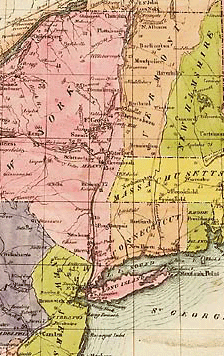
Detail,
map of northeastern United States from Jaques Milbert, Itineraire
Pittoresque du Fleuve Hudson, 1828. |
| Western World. The Hudson's
main tributary is the eastwardflowing Mohawk River; in addition
to Albany and New York, its principal cities are, north
to south, Troy, Hudson, Kingston, Poughkeepsie, Newburgh,
Peekskill and Yonkers in New York State, and Weehawken,
Hoboken and Jersey City in New Jersey. |
| Life on the river was transformed
when inventor Robert Fulton inaugurated a new era of water
navigation in 1807, piloting his North River Steamboat,
later known by its popular name, the "Clermont."
Beginning in 1820, the Erie Canal connected the Hudson to
the Great Lakes and soon after the Delaware & Hudson
Canal linked the river to Pennsylvania coal fields supplying
the raw materials and fuel that transformed New York City
into the great American metropolis. The Hudson's importance
as one of the nation's main arteries of trade continued
to grow. The "DeWitte Clinton" locomotive first
ran on track built along the river's edge. In 1853 the New
York Central Railroad consolidated many smaller lines to
funnel freight and passengers into the city from a rail
network that soon stretched across the continent.
|
|
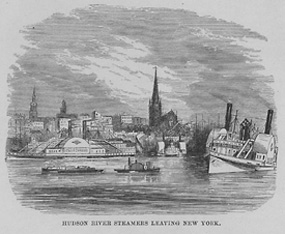
Hudson
River steamers leaving New York. From Benson J. Lossing,
The Hudson, From the Wilderness
to the Sea. 1866 |
Transportation in the Hudson region was arduous before the introduction
of steam-powered boats. Travelers and trade goods moved unpredictably,
often stalled by unfavorable winds on the river or mired in
the muddy roads paralleling it. Steamboats' ability to carry
passengers and freight between New York and Albany on schedule
revolutionized water travel and ushered in a new age of technological
advancements in transportation.
Water transportation and travel were at a peak in 1850, when
railroads began to compete for freight and passengers. While
trains never completely replaced riverboats, they represented
the next level of improvement in transportation engineering
and ease of travel. For the first time in the Hudson's history,
land travel was superior to that on water, and freight traffic
and tourism both increased significantly. Fortunately for tourists,
the Hudson River Rail Road hugged the shoreline and was nearly
as scenic as the boats.
TOURISM
|
Tourists came from all parts of the United States and
Europe to see the Hudson. It was an important leg in trips
to Saratoga Springs, the Adirondacks, Niagara Falls, and
Canada, as well as a destination itself, particularly
in the Catskills where many tourist hotels were located.
West Point and other Revolutionary War sites were as popular
with visitors throughout the 19th century as they are
today, but for most travelers, the region's natural scenery
and its splendid river houses were the principal attractions.
These sights were best appreciated from the water. Most
tourists visited the Hudson River without stepping ashore
between New York City and Albany. Passenger
boats became ever larger and faster as the century advanced.
Eventually, the 150-mile trip was made within a single
day. There were day boats and night boats; from the latter
shoreline landmarks were viewed by searchlight.
|
|
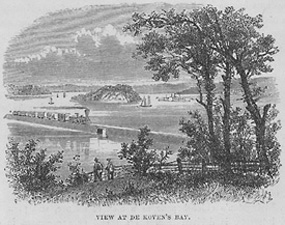
'View
at De Koven's Bay.' From Benson J. Lossing,
The Hudson, From the Wilderness to the Sea. 1866
|
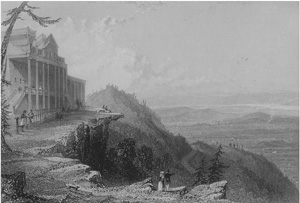
View
from the Mountain House, Catskill. Steel
engraving from watercolor view by William
H. Bartlett. From American Scenery. 1840.
|
|
Once in Albany,
some travelers headed west to Niagara on Erie Canal packet
boats or overland through the Mohawk River Valley; others
went north by canal to Lakes George and Champlain and on
to the Adirondacks. Travelers to the "Springs"
at either Ballston or Saratoga enjoyed the luxury of one
of the earliest railroads in America. These travelers used
guidebooks to direct them through New York City, to the
boats, and on up the Hudson, as well as to point out landmarks
along the way. |
While foreign travelers tended to head through the region,
the Hudson River hosted tremendous numbers of New Yorkers looking
to escape the city and engage with nature. This pastime was
popular with elite and common people alike, for the river's
advanced transportation services made it easy for city dwellers
of all classes to visit in the country if only for a day. Overnight
and long-term visitors stayed in hotels on the Palisades and
in the Hudson Highlands, two of the more dramatic scenic areas
in close proximity to the city. Inexpensive excursion boats
transported day-trippers.
ART & LITERATURE
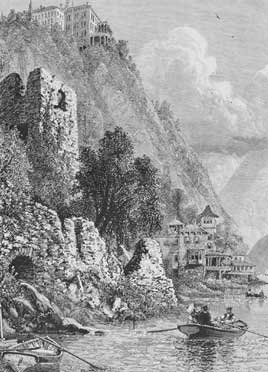
'The
Hudson at "Cozzen's." ' Wood engraving by Harry
Fenn. From Picturesque America. William Cullen Bryant,
ed. 1872.
|
 |
Prominent among Hudson River recreationists were artists
and writers. Wrapped up in Romantic sensibilities, they
attempted to capture the intangible essence of the region's
picturesque natural landscape in image, verse and prose.
The combination of a great reservoir of artistic talent
in the city and the proximity of the Hudson's sublime
scenery resulted in one of the most productive and significant
eras of art and literature in American history.
The artists who created the legendary canvases of the
Hudson River and Catskills in this era are known as the
Hudson River School. These painters, such as Thomas Cole
(pictured with poet William Cullen Bryant in Asher B.
Durand's 1849 painting "Kindred
"Spirits", Frederick Church, Sanford Gifford,
William Kensett, and Jasper Cropsey were very familiar
with the dramatic rustic locales and the taste of wealthy
city patrons. Each year to great fanfare, new works were
displayed in fashionable art galleries in the city. The
most popular paintings were quickly engraved on steel
plates and printed by the hundreds for sale to audiences
of more modest means. Prints and illustrations also helped
to maximize the financial return painters received from
their successful works.
|
Asher B. Durand was
New York's premier engraver, as well as a painter; but other
engravers and lithographers created Hudson River views for
reproduction and publication. Illustrating the vast scale
of this industry, it was prints of New York and Hudson River
scenes that established the reputation of the renowned American
lithographers and publishers, Currier and Ives, and they
were only one of many firms engaged in the business. In
1874, poet and publisher William Cullen Bryant edited Picturesque
America, a two-volume compendium of essays and poetry by
writers well-known in their regions, illustrated by wood-engravings.
- Prints and illustrations, from the 1820s to 1874,
representing the most popular images from the era are
presented in: Prints
and Guidebooks
|
|
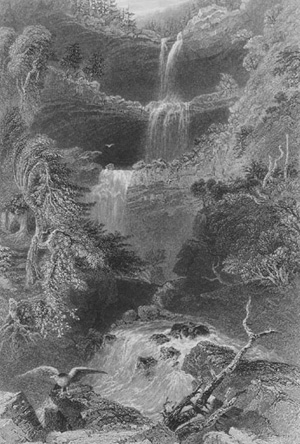
The
Catterskill Fall. Steel engraving from watercolor view
by William H. Bartlett. From American Scenery.
1840.
|
|
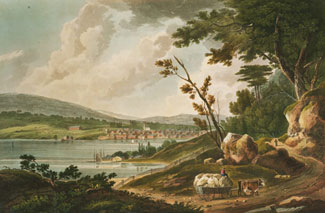
'Newburg'
Aquatint of watercolor by William Guy Wall. From Hudson
River Port Folio. 1820
|
|
French
artist Jacques Milbert toured the Hudson River region in
the 1820's and compiled a series of colored drawings of
views he encountered on his trip. Upon his return to Paris,
he wrote an account of his travels that was published illustrated
with lithographs of the views. This publication introduced
the beauties of the Hudson River to the European public.
Thirty of the fifty-four views depict the region and are
included here. William Henry Bartlett, an English watercolorist,
made his first trip to North America in 1836 and began producing
colored drawings of views made popular
by American and European travelers. |
In 1840, a two-volume compendium of steel engravings of these
views was published simultaneously in London and New York with
the title American Scenery. Novelist Nathaniel Parker Willis provided
Romantic descriptions for the 118 views. Numerous engravers were
employed to create steel engravings of Bartlett's views. Forty-seven
views of the Hudson River region are included here.
| Poet
and publisher William Cullen Bryant edited a two-volume
work about the United States, which included essays by writers
well-known in their regions, each illustrated by wood engravings
of prominent views. Views from the five chapters dealt with
the Hudson River region and are included here.
In the last half of the 19th century, photography and
photographic duplication processes quickly supplanted
the hand-made, mechanically-reproduced prints that had
made the images of Hudson River popular
for previous generations. In some cases, traditional views
were reproduced, but the advent
of photography generally changed the way the river was
represented. Romantic,
|
|
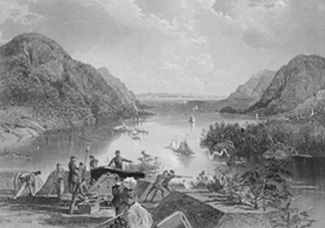
West
Point and the Highlands.' Steel engraving from painting
by Harry Fenn. From Picturesque America. William
Cullen Bryant, ed. 1872 |
pastoral views were few; documentary and action-based
images were more the norm. Some very early photographs of subjects
and scenes in the Hudson River region are contained in the Photography
section of the Collections. There is also a link to the extensive
digital presentation of the NYPL Dennis Collection of stereograph
views of New York, Small Town America, where hundreds of images
of the Hudson River can be found.
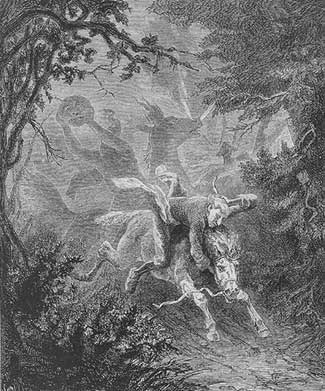
Scene
from the 'Legend of Sleepy Hollow,' by Washington Irving.
Hudson Legends edition, 1867
|
|
The Hudson River
was also the source of an indigenous American literature.
Within the young nation Washington Irving is considered
the first man of letters to emerge, his renown based on
his Hudson River tales published in 1819-1820.
- Prose sections of American Scenery (1840) by novelist
Nathaniel Parker Willis and Picturesque America (1874)
by poet William Cullen Bryant are presented in searchable
text format
In the 19th century, American writers began to look back
on the history of the Hudson and reflect on its significance.
They, along with the artists, were motivated by a desire
to create a cultural identity for the nation. The river's
central role in New York's particular Dutch colonial history,
the Revolutionary War, the construction of the Erie Canal,
and the growth of commerce and industry provided historians
with gripping subjects.
The region's most important 19th-century chronicler, Dutchess
County native Benson J. |
Lossing (1813-1891) traveled the length of the
Hudson recording its historical events and sketching its natural
and cultural landmarks. In 1866, Lossing published The Hudson,
From the Wilderness to the Sea with more than three hundred wood
engravings, an encyclopedic compendium that continues to captivate
its readers.
-
Consult Benson J. Lossing's 1866 history of
the Hudson River in searchable
text
| In the 19th century,
writers were beginning to look back on the history of the
Hudson and reflect on its significance. This was also motivated
by a desire on the part of American artists and writers
to create a cultural identity for the nation. The river's
central role in New York's peculiar Dutch colonial history,
the Revolutionary War, the construction of the Erie Canal,
and the growth of commerce and industry provided historians
with gripping subject material. A searchable text version
of Benson J. Lossing's 1866 history of the Hudson River
can be found in the History
section of Collections. |
|
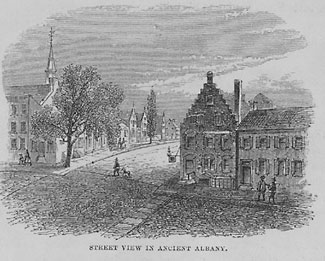
Street
View in Ancient Albany. From Benson J. Lossing. The Hudson,
from the Wilderness to the Sea. 1866. |
|